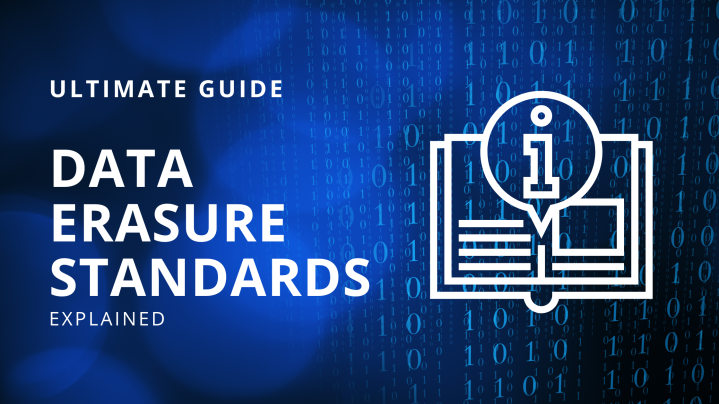



Data erasure software uses standards that are called wiping schemes, but some organizations may also refer to them as data sanitization methods, guidelines or algorithms. Whatever you call them, these standards have been put together by government agencies and private organizations to protect the digital information of enterprises by establishing secure, rigorous procedures for data removal.
You may have heard of the Department of Defense’s DoD 5220.22-M, which is one of the most recognizable and widely used wiping schemes. But what are wiping schemes, exactly, how do they differ from each other, and how should you determine which one to use? In this blog, we will answer all those questions and more.
Data wiping is the process of overwriting and permanently removing the contents of a file or disk space, which in turn empowers organizations and individuals to uphold data privacy and prevent data breaches. In order to overwrite data, we have to talk about wiping schemes. Wiping schemes consist of a set of rules that differentiate them from one another: overwriting passes, erasure patterns and verification. So, without further ado, let’s pry open a wiping scheme and see what’s inside.
When looking at different wiping schemes, the first distinguishing feature that will jump out at you is likely to be the number of overwriting passes that each scheme contains. If a wiping scheme has 1 overwriting pass, such as the British Baseline, that means the data in question will be overwritten once. Wiping schemes with more passes provide added security by overwriting data multiple times, such as the DoD 5220.22-M with 3 passes or the Peter Gutmann method with 35 passes.
Not only do the number of overwriting passes differ between wiping schemes, but also the type of data that is written to the drive during each pass. There are 3 main ways to proceed:
Fixed pattern: A defined binary pattern for overwriting data, such as 1010.
Complementary: Following on from fixed patterns, complementary patterns reverse the binary data of the previous overwrite. For example, the complementary to 1010 would be 0101. Complementary erasure patterns are important to use with HDDs, as writing the same character again and again leads to the threat of data being recoverable due to residual magnetism.
Random: Randomly generated data.
Most standards use a combination of the 3 types of erasure patterns outlined above. For example, Jetico’s HDD wiping scheme. The first pass of this 7-pass wiping scheme overwrites existing drive data with a binary ‘00’ pattern. Passes 2-6 are labelled as complementary, meaning that each subsequent pass will reverse the pattern of the preceding one. The final pass overwrites data with a random pattern.
A final verification step that checks all data has been removed from the drive is sometimes included with software. This step makes the wiping process take slightly longer, but it’s important to use software that provides this option as some standards require verification.
While the most well-known standards are the DoD 5220.22-M and the extended DoD 5220.22-M ECE, there are a number of wiping schemes that are widely used internationally or within certain industries. Let’s take a look at them in alphabetical order:
With so many options available, how should you decide which wiping scheme to use for a particular job? Here’s a 3-point checklist to help you make the right choice:
1. Check Your Compliance Requirements
Before securely erasing data, the single most important thing to check is if you are required to comply with a particular standard. Keep in mind that your industry may have already set clear guidelines on which standard has to be used.
2. Consider the Type of Drive
HDDs and solid-state drives (SSDs) require different wiping schemes to securely erase data. Generally speaking, a combined total of 7 fixed and complementary overwriting passes are enough to avoid problems related to residual magnetism for HDDs. For SSDs, it’s the generating of random data rather than the number of passes that’s important. BCWipe’s proprietary HDD and SDD wiping schemes are Jetico’s recommended choice for wiping both types of drive.
3. Consider Your Timetable
The Peter Gumann method with its 35 passes is arguably the most secure wiping scheme, but it obviously takes a great deal of time to run. In addition to compliance and drive considerations, it's important to factor in the sensitivity of the data you’re erasing and the amount of time you can realistically set aside for the operation.
Trusted for over 15 years by the U.S. Department of Defense, Jetico’s data wiping solutions remove digital information beyond forensic recovery and support all the standards listed in the How Many Wiping Schemes Are There? section of the blog, including the DoD 5220.22-M, DoD 5220.22-M (ECE) and NIST SP 800-88, Rev. 1.
BCWipe Total WipeOut is the choice to wipe entire hard drives, while BCWipe is used to wipe individual files and folders. By simply ticking a checkbox, users can also add a verification step to the end of data erasure operations with both BCWipe Total WipeOut and BCWipe.
To get started with Jetico’s data wiping solutions, contact our Data Protection Specialists and request a free trial. To learn more about how to wipe hard drives clean, read our ultimate guide.

Jetico Technical Support helps customers find answers...
- Access our knowledge base articles
- Watch our How-To videos
- Contact us for insights
